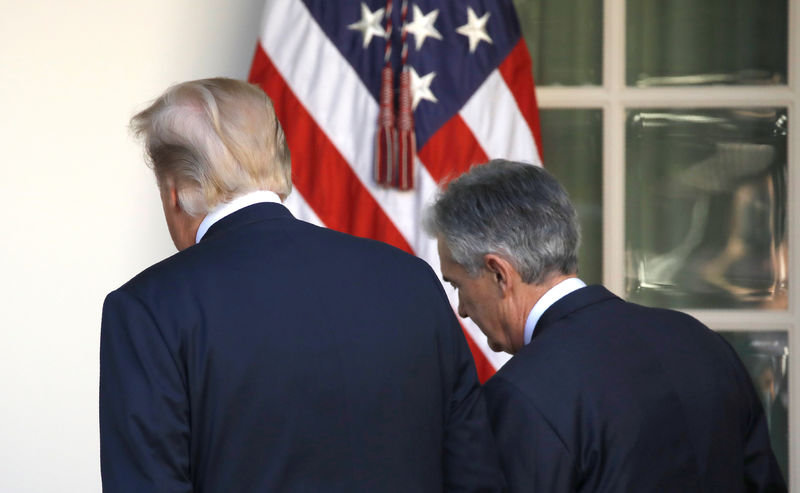By Howard Schneider
WASHINGTON (Reuters) - The U.S. Federal Reserve has a purely domestic mandate, answerable to an elected Congress and facing nearly daily demands from an outspoken president.
But the fate of recent Fed policy decisions may have been written far outside the borders of the United States. As much as officials felt they could raise interest rates last year because U.S. economic conditions seemed ripe for it, the about-face in the last few months has shown just how bound the Fed has become to the rest of the world.
"We have become interconnected in a way that we are almost in a prisoner's dilemma - stuck in this equilibrium where no one can escape" from a decade of low interest rates, said Raghuram Rajan, a former Reserve Bank of India governor and current professor at the University of Chicago Booth School of Business.
"Nobody wants to be ahead of the pack," and risk the types of changes the Fed has had to deal with, from an appreciating currency to renewed volatility in asset markets, Rajan said.
Whether it was China's choice to battle President Donald Trump's trade war on a tit-for-tat basis, foreign companies' dependence on cheap dollar debt, or European and Japanese officials' inability to get their economies off the mat, external forces ultimately proved too much for the Fed.
After a fitful, three-year rate hiking cycle, the U.S. central bank was forced to shift gears late last year and is now lowering borrowing costs, joined by 19 other central banks whose collective policy easing emphasizes the point.
When global policymakers gather this week at the Fed's annual conference in Jackson Hole, Wyoming, aside from fly fishing and hiking they'll think at length about whether their prison sentence amounts to a life term. Can they return to a time when economic and monetary policy conditions could diverge among countries and major currencies?
Increasingly, the answer seems to be no.
Forces like aging populations in advanced countries, low productivity growth and other hard-to-change dynamics appear to be holding down interest rates and inflation. Meanwhile, the dollar's role has only grown, as neither the highly managed Chinese yuan nor the moribund euro have proved competitive alternatives for corporate finance or safe-haven investment.
With a global slowdown taking grip, the central bank may find its tools more limited in scope and impact than in the past – a chief reason the Fed is reviewing issues like how it might again use programs like bond buying once considered unorthodox but now in the mainstream.
"There is not enough monetary policy space to deal with the next downturn," a team from the BlackRock (NYSE:BLK) Investment Institute that included former Fed Vice Chairman Stanley Fischer wrote recently.
RISKS OF GOING IT ALONE
The Fed has long been the world's de facto central bank, but the decade since the last financial crisis has shown interest rates are more than ever globally determined, said Maurice Obstfeld, an economics professor at the University of California, Berkeley, and a former International Monetary Fund chief economist.
The Fed, in that environment, isn't free to choose its targets without factoring in the wider world, or act without understanding whether other countries will be impacted in ways that would ultimately hurt back home.
The low global rates environment "makes a case for the Fed to loosen even if the U.S. economy is strong," as it recently did, said Obstfeld, who presented a key paper on the topic at a recent Chicago Fed conference. "The rest of the world is going to matter a lot."
The Fed's effort to go its own way and tighten policy between 2015 and last year opened an interest-rate gulf between the United States and rest of the world. In turn, the dollar appreciated, and a mercurial president took notice.
"The Fed Rate, over a fairly short period of time, should be reduced by at least 100 basis points," Trump tweeted this week in his latest call for lower rates. He, too, chimed in on the Fed's global impact, saying current U.S. policy was "sadly hurting other parts of the world."
Even if the Fed's global role is recognised, deciding what to do about it may be difficult.
Rajan has called in the past for more direct coordination among the world's central banks, but acknowledges the political difficulties of that at a time when nationalist sentiment runs strong.
But if credit conditions and interest rates are now more closely bound, and movements in exchange rates felt more acutely, the case for coordination becomes stronger, said Adam Posen, a former Bank of England policymaker and the current president of the Peterson Institute for International Economics.
Just in the last decade, the European Central Bank and the Fed have twice been out of sync - early in the crisis when the ECB kept policy tight and even tried to raise rates early on, and over the past few years when the Fed pursued its rates "liftoff."
The policy challenges faced by most central banks over that time may have made the message clear.
"There is a limit to what one central bank can do, even if you are the Fed," Posen said. "If monetary and credit conditions are moving in the same direction there are probably large gains to be had with coordination."

(For a graphic on 'The weight of the world on the Fed', click https://tmsnrt.rs/2Zfs70T)